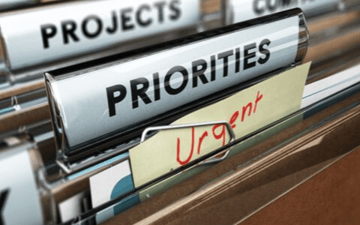What is a work priority index?
A work priority index is a method used in maintenance and reliability to determine the proper allocation of resources. Determining a work order’s priority index is based on a combination of the criticality of the asset and the importance of the work being performed.
Every maintenance planner needs to prioritize work orders to ensure critical assets don’t break down and disrupt production. Establishing a work priority index is vital, but it is really just a way of formalizing an obvious bit of common sense: the most important tasks are carried out first.
A desire to decrease downtime on assets drives the need for prioritization. You can also look at it as an acknowledgement that resources are always in limited supply. There are only so many craftspeople and they can only perform so many tasks per day. It’s also tremendously useful when it comes to managing your backlog. For more on this, please see “Maintenance Backlog: Take Control with a Priority Index.”
You wouldn’t need to prioritize maintenance work in a perfect world. You would have enough craftspeople and technicians to complete all maintenance work. There are always enough resources to do everything at once in that perfect world. Not only that, but rain cures baldness and everyone gets a free puppy.
You know we don’t live in a perfect world. There is no chance that you’ll ever have unlimited resources. Frankly, you’ve got a better chance of getting the puppy.
Back in the real world, there are harsh truths that maintenance professionals must acknowledge:
- There will always be limits on the resources you have at your disposal.
- Certain assets will always be more critical to production than other assets.
- Some maintenance tasks will always be more time-sensitive than others.
People in the maintenance field have always had to deal with these three factors. This is true even if a facility is only practicing reactive maintenance. It may seem that a reactive maintenance strategy, where assets only receive service and repair when they break down, does not acknowledge asset criticality or work priority.
Those ideas may not seem crucial if you’re only practicing reactive maintenance. However, you will see asset criticality and work prioritization rise to the fore if two or more assets break down at the same time. At that point, the maintenance department will naturally focus their attention on what they see as the most critical asset.
Establishing a work priority index means you don’t go into a frenzy to figure out which asset or which task is most critical at the time of failure. Your work priority index, prepared in advance, tells you this.
The good news is that you can start building a work priority index today, using the four steps outlined below.
1. Assign Asset Criticality
The first step is to give all your assets numbers from 1 to 100. The higher the number, the more critical the asset is to production.
The biggest challenge with this step lies in determining exactly which assets are the most critical. We’re sorry to say that there may be no easy solution for this.
There are some assets under your care that are obviously of low priority when it comes to production. A flickering light in the bathroom is annoying but it’s unlikely to impact production significantly. A flickering light over the lathe operator is more likely to interfere with production and is therefore more critical.
The assets that will give you the most trouble when it comes to assigning criticality are the ones near the top of the list. For example, say you have two conveyor belts that feed parts to the same group of assembly workers. The workers cannot produce without both types of parts. It seems logical that both belts are of equal priority. Logical, but not necessarily true. What if one belt carries exceptionally large, heavy parts, while the other carries parts that are much lighter and smaller? In this case, it might be possible for one of the workers to simply walk to the other end of the factory, pick up an entire box of parts, and walk it back to the assembly area.
This is obviously very inefficient, or you wouldn’t have bothered putting in the conveyor belt in the first place. However, it means that production can still limp along. The other conveyor belt moves parts that cannot be carried by hand and is therefore more critical, as production will cease at once when it goes down.
Be prepared to change the listings on your asset criticality as you consider the entire situation. You may discover that an asset you had originally rated as a 100 is a 90 or an 80. Don’t be afraid to alter those numbers as you go. Nothing is set in stone at this stage.
2. Confer With Operations
Take your asset criticality list to the operations department and ask them to look it over. Your list at this point is close to its final form, but it’s essential that operations agrees with your assessment.
There are two barriers to the success of this stage. The first is that operations won’t meet with you or keeps putting the meeting off. You can usually get around this by letting their department head know exactly why you want the meeting and stressing that you don’t need the whole department. Establishing asset criticality is just as much to their benefit as it is yours.
The second barrier is psychological. You know maintenance, you know your facility, and you know your assets. You also spent a long time developing and refining your asset criticality list. This can make it exceedingly difficult to give other people the last word.
Nevertheless, you must put your ego in check and listen to what the operations staff has to say. They know production just as well as you know maintenance. Be prepared to give them the final say on exactly which assets are most critical.
3. Prioritize Work Orders
At this stage, you start assigning priority numbers to work orders, using the same method you used to set up asset criticality. Again, the higher the priority, the higher the number.
Exercise your judgment and common sense when assigning work order priority. This is simple to say but harder to achieve in practice.
For example, it may seem like work on a high-priority asset that has already failed is more important than the equivalent work on an asset of equal priority that is still running. This will usually be the case, but it doesn’t apply in every situation.
You plan and schedule the necessary work on the failed asset, secure in the belief that the work is of higher priority. What happens if the other asset breaks down in the meantime? Now you’re looking at more lost production. It may have been better to perform the needed maintenance on the asset that was still running.
This is part of why assigning work order priority is simple in theory and challenging in practice. You will have to use everything you know about your assets and maintenance best practices to make sure that you’re assigning the correct number.
4. Create Your Index
You now have the tools you need to create your work priority index. Multiply the asset criticality by the work order priority. The result is the work priority index.
Work Priority Index = (Asset Criticality) x (Work Order Priority)
For example, say you have a pump with an asset criticality of 50. It’s not the highest priority asset in your facility but it’s not inconsequential to continued production either.
A recent inspection shows two issues with the pump. First, the casing of the pump is close to failure and must be repaired or replaced. The pump will completely shut down if the casing fails. Second, an impeller in the pump has eroded and its discharge pressure has declined. It’s still working in the second case, but not at maximum efficiency.
You assign the casing a priority of 75 and the impeller a priority of 65. Multiplying by the pump’s asset criticality score of 50, we get a work priority index score of 3,750 in the first case and a score of 3,250 in the second. The casing must therefore take priority over the impeller.
These tools are extremely useful for prioritizing work. However, the value and power of knowing exactly how to deploy maintenance resources for maximum impact will end up improving many business processes that fall outside of maintenance.
This is the view espoused by Scott Gorsuch, Former Director of Reliability Strategies for Alcoa GPP:
Gorsuch writes: “The valuable insights gained from knowledge of criticality can extend beyond asset maintenance planning and execution and ripple throughout the organization. It has the potential to improve business decisions about maintenance strategies and risk management as well as inventory, procurement, maintenance budgeting, and continuous improvement.
“The cumulative effect brings greater stability and predictability to the equipment, systems, and operations. Ultimately, fully leveraged criticality filters can drive operational improvements that are reflected in overall business performance and profitability.”
Maintenance has a complex workflow that starts with identifying the work. That is only the start, though. You must make decisions at many points in the process to ensure tasks are carried out. After the need for the work is identified, it needs to be planned, scheduled, completed, executed, and analyzed.
Building a work priority index helps to take guesswork out of the decision-making process. Using the right software can help you at every stage, from identification to analysis. Get in touch with a member of the Prometheus Group team and let us show you how we build software that will help you manage the entire maintenance workflow.

